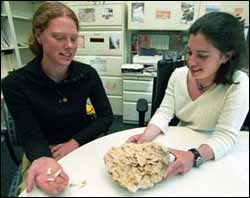Scientists find fossil proof of Egypt’s ancient climate

Earth and Planetary Sciences graduate student Johanna Kieniewicz (left) holds 130,000 year-old snail fossils from an Egyptian lake while Jennifer R. Smith, Ph.D., assistant professor of earth and planetary sciences in Arts & Sciences, examines leaf impression in tufa, a spring carbonate rock found at the same site. The researchers are trying to infer the Egyptian climate from the fossil evidence. David Kilper / WUSTL Photo
’At a snail’s pace’
Earth and planetary scientists at Washington University in St. Louis are studying snail fossils to understand the climate of northern Africa 130,000 years ago.
While that might sound a bit like relying on wooly bear caterpillars to predict the severity of winter, the snails actually reveal clues about the climate and environment of western Egypt, lo those many years ago. They also could shed light on the possible role weather and climate played in the dispersal of humans “out of Africa” and into Europe and Asia. Periods of substantially increased rainfall compared to the present are known to have occurred in the Sahara throughout the last million years, but their duration, intensity, and frequency remain somewhat unconstrained.
Jennifer R. Smith, Ph.D., Washington University assistant professor of earth and planetary sciences in Arts & Sciences, and her doctoral student Johanna M. Kieniewicz, are using stable isotope and minor element analyses of the freshwater gastropod Melanoides tuberculata and carbonate silts from a small lake (now dry) in the Kharga Oasis of western Egypt to reconstruct climatic conditions during the lifetime of the lake. Their analyses support a surprising picture of arid Egypt: 130,000 years ago, what everyone considers an eternal desert was actually a thriving savannah, complete with humans, rhinos, giraffes and other wild life.
Evidence for the hominin presence abounds near the lake in the form of Middle Stone Age artifacts such as stone scrapers and blades. “The artifacts provide a record that people were coming to the lake,” said Smith. “Genetic evidence suggests that 100,000 to 400,000 years ago was a critical time in the evolution and dispersal of African hominins. Our climate data from this 130,000-year-old humid event suggest that this would have been a particularly good time for a northward migration through Africa following reliable water resources, since it seems to be the strongest humid phase in this region over the past 400,000 years. We’re also testing the hypothesis that humid events were more frequent than previously thought, which would have allowed for greater mobility throughout the region.”
The researchers noted that the silt thickness at the lake exceeds five yards, an indication that the humid phase lasted at least several thousand years. Normal rainfall in the area they study is a minuscule 0.7 of a millimeter per year, but there is evidence that the rainfall amounts in the region have gotten up to as much as 600 millimeters per year, “not enough to make it a paradise,” Smith said, “but enough to turn a barren environment into a classic savannah.”
Kieniewicz performed isotopic analyses of about 20 snails, all of them dating to the humid phase, which occurred approximately 130,000 years ago. These particular snails have a life span of between one and two years, and build their shells in a classic spiral with whatever water is available that day. The snails were preserved in calcium carbonate deposits throughout the lake.
“We’re using the chemistry of the water over the course of a year or two, as revealed by isotopic analyses and minor element analyses of the snail shells to determine information about the climate then,” Kieniewicz said. “The shell is an archive of the snail’s life. The analyses give us snapshots of what the conditions were like in that lake basin.”
The geochemical analyses confirmed that the water was a stable standing body for many years. “Strong evaporation of the lake, enough to shrink it substantially in volume and make it more saline would have been expected to result in large excursions in ä18O and minor element concentrations,” Kieniewicz said. “However, throughout the stratigraphy, the ä18O values of the silts remain isotopically light and the minor elements do not show intense evaporative trends, suggesting that the lake remained stable and fresh.”
Smith and Kieniewicz attended the 116th annual meeting of the Geological Society of America, held Nov. 7-10 in Denver. Kieniewicz presented a paper there on their findings.
Smith’s specialty is geoarchaeology, which uses classic earth science methods and concepts to address questions of archaeological interest.
“In this particular study, we’re interested in building a history of climate change through time to understand how people would have responded to dramatic shifts in climate,” said Smith. “This is a major theme of our work, and we hope that some of our findings can give us perspective on what we’re facing in the coming centuries.”
Media Contact
More Information:
http://www.wustl.eduAll latest news from the category: Earth Sciences
Earth Sciences (also referred to as Geosciences), which deals with basic issues surrounding our planet, plays a vital role in the area of energy and raw materials supply.
Earth Sciences comprises subjects such as geology, geography, geological informatics, paleontology, mineralogy, petrography, crystallography, geophysics, geodesy, glaciology, cartography, photogrammetry, meteorology and seismology, early-warning systems, earthquake research and polar research.
Newest articles

Parallel Paths: Understanding Malaria Resistance in Chimpanzees and Humans
The closest relatives of humans adapt genetically to habitats and infections Survival of the Fittest: Genetic Adaptations Uncovered in Chimpanzees Görlitz, 10.01.2025. Chimpanzees have genetic adaptations that help them survive…

You are What You Eat—Stanford Study Links Fiber to Anti-Cancer Gene Modulation
The Fiber Gap: A Growing Concern in American Diets Fiber is well known to be an important part of a healthy diet, yet less than 10% of Americans eat the minimum recommended…

Trust Your Gut—RNA-Protein Discovery for Better Immunity
HIRI researchers uncover control mechanisms of polysaccharide utilization in Bacteroides thetaiotaomicron. Researchers at the Helmholtz Institute for RNA-based Infection Research (HIRI) and the Julius-Maximilians-Universität (JMU) in Würzburg have identified a…



